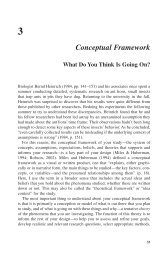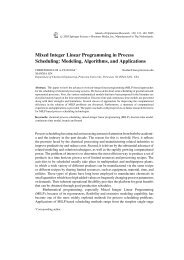1 TAME synthesis problem Tert-Amyl Methyl Ether (TAME) is an ...
1 TAME synthesis problem Tert-Amyl Methyl Ether (TAME) is an ...
1 TAME synthesis problem Tert-Amyl Methyl Ether (TAME) is an ...
You also want an ePaper? Increase the reach of your titles
YUMPU automatically turns print PDFs into web optimized ePapers that Google loves.
Algorithm to solve the <strong>problem</strong><br />
We have a non-linear system of Ordinary Differential Equations (ODE) to solve:<br />
⎧ 1B<br />
⎪ − ℜ1B<br />
= 0<br />
⎪<br />
2B<br />
⎪ − ℜ2<br />
B = 0<br />
⎪<br />
⎪ M<br />
⎨ − ℜ M = 0<br />
⎪<br />
⎪<br />
dfT<br />
− ℜT<br />
= 0<br />
⎪ dX<br />
3<br />
⎪ dT b<br />
⎪ − ∑<br />
⎩ dX Cp j=<br />
dX<br />
df<br />
dX<br />
df<br />
dX<br />
df<br />
ρ τ<br />
ε<br />
ρ<br />
1<br />
R ( ∆H<br />
r ) + NTU ( T −T<br />
)<br />
j<br />
j<br />
w<br />
= 0<br />
The program we developed uses subroutine DDASSL (Bren<strong>an</strong> et al., 1989) to solve th<strong>is</strong> system. Th<strong>is</strong><br />
code solves a system of differential/algebraic equations of the form delta(t, y, yprime)=0, with<br />
delta(i) = yprime(i) – y(i), using the backward differentiation formulas of orders one trough five. t <strong>is</strong><br />
the current value of the independent variable (in our case t = X), y <strong>is</strong> the array that contains the solution<br />
components at t (in our case we have: y(i) = f(i), i=1,4 <strong>an</strong>d y(5) = T) <strong>an</strong>d yprime <strong>is</strong> the array that<br />
contains the derivatives of the solution components at t.<br />
The program solves the system from t to tout <strong>an</strong>d it <strong>is</strong> easy to continue the solution to get results at<br />
additional tout. In our case, we are going to get results at different values of X, between 0 <strong>an</strong>d 1.<br />
Th<strong>is</strong> <strong>problem</strong> <strong>is</strong> rather complex because most of the other variables depend on yi: the kinetic, adsorption<br />
<strong>an</strong>d thermodynamic equilibrium “const<strong>an</strong>ts” depend on T (y5), the reaction rate <strong>an</strong>d the components rate<br />
of formation depend on yi (fi (i=1,4) <strong>an</strong>d T), as the activity coefficients.<br />
In Figure 2 <strong>is</strong> the algorithm to solve our <strong>problem</strong>.<br />
(1)<br />
10
















